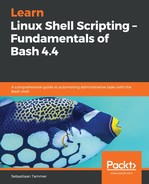Now you can start your virtual machine from the VirtualBox main screen. Right click on the machine, select Start followed by Normal Start. If all goes well, a new window will pop up, showing you the virtual machine console. After a while, you should see the Ubuntu server installation screen in that window:
- On the screen shown in the following screenshot, select your favorite language using the arrow keys (we're using English, so if you're not sure, English is a good choice) and press Enter:

- Select the keyboard layout that you're using. If you're unsure, you can use the interactive Identify keyboard option to determine which layout is best for you. Once the proper layout is set, move the focus to Done and press Enter:

- We now choose the type of installation. Because we're using the server ISO, we do not see any options related to the GUI. In the preceding screenshot, select Install Ubuntu (both other options use Canonical's Metal-As-A-Server (MAAS) cloud offering, which is not relevant for us) and press Enter:

- You will see the Network connections screen. The installer should default to using DHCP on the default network interface that was created with the virtual machine. Verify that an IP has been allocated to this interface, and press Enter:

- The Configure proxy screen is not relevant to us (unless you're running with a proxy setup, but there's a good chance you do not need our assistance with the installation in that case!). Leave the Proxy address blank and press Enter:

- Sometimes it's helpful to manually partition your Linux disk to fit specific needs. In our case, the default value of Use An Entire Disk is a great fit, so press Enter:

- After having selected that we want to use an entire disk, we need to specify which disk to use. Since we only created one disk when we configured the virtual machine, select it and press Enter.
- Now you will encounter a warning about performing a destructive action. Because we are using an entire (virtual!) disk, all information present on that disk will be erased. We created this disk when we created the virtual machine, so it does not contain any data. We can safely perform this action, so select Continue and press Enter:

- For the Filesystem setup, once again the default values are perfect for our needs. Verify that we have at least 10 GB of hard disk space (it might be a little less, like 9.997 GB in the following example: this is fine) and press Enter:

- The Ubuntu server should now start installing to the virtual disk. In this step, we'll be setting the server name and creating an administrative user. We've chosen the server name ubuntu, the username reader, and the password password. Note that this is a very weak password that we will only use on this server for simplicity. This is acceptable because the server will only ever be accessible from our host machine. When configuring a server that accepts incoming traffic from the internet, never use a password as weak as this! Choose anything you like, as long as you can remember it. If you're unsure, we'd advise using the same values of ubuntu, reader, and password:

Now that you've chosen a server name and configured an administrative user, press Enter to finalize the installation.
- Depending on how long it took to complete the previous screen and how fast the host machine is, Ubuntu will either still be installing or will have finished already. If you still see text moving around the screen, the installation is still running. Once the installation is completely finished, you will see the Reboot Now button appear. Press Enter:

-
After a few seconds, a message stating Please remove the installation medium, then press Enter should appear. Follow the instructions and, if all goes well, you should be greeted with a terminal login prompt:

- Now the moment of truth: try to log in with your created username and password. If successful, you should see a screen similar to the following:

Give yourself a pat on the back: you have just created a virtual machine, installed Ubuntu Server 18.04 LTS, and logged in via the Terminal console. Well done! To exit, type exit or logout and press Enter.
